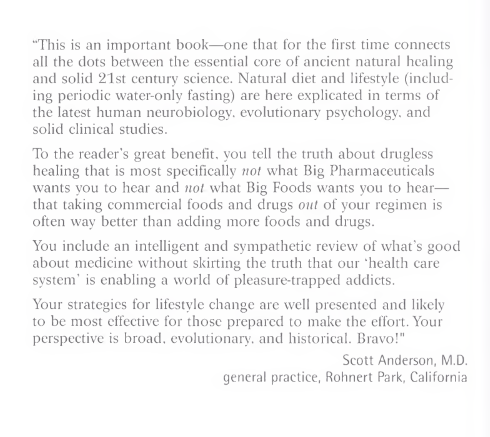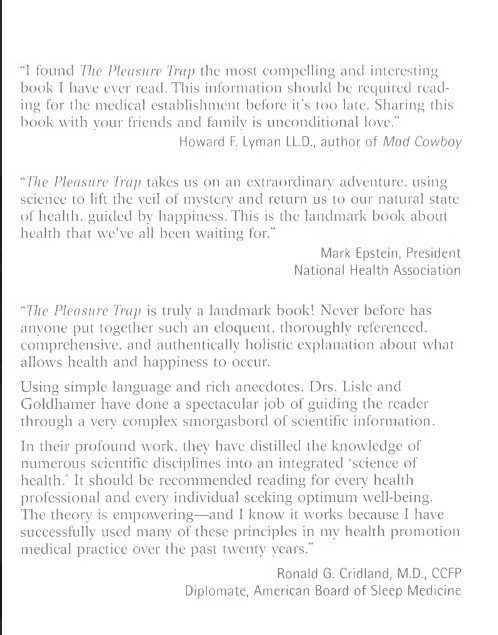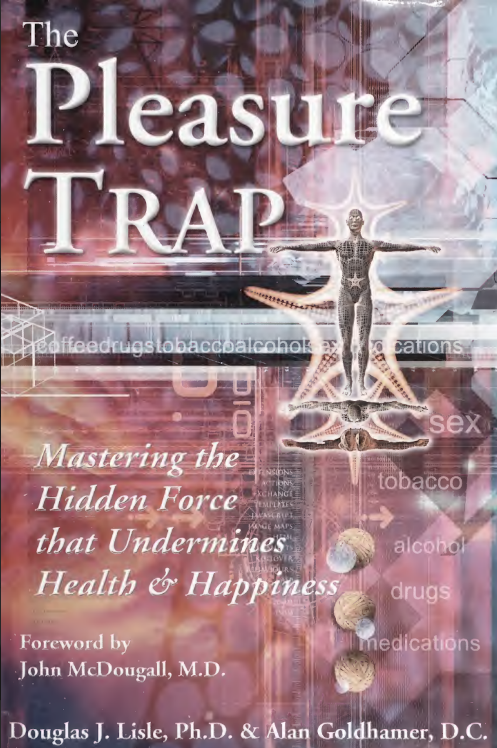


Tfic Pleasure lYap lias helped me solve the most ehallenging problem of my medieal praetiee: Why is it so diffieiilt for people to adopt a health- ful diet and lifestyle—despite the obvious and overwhelming benefits? Sinee 1976, I have known how people ean lose weight without ever being hungr\’; eure most eases of arthritis, diabetes, and hypertension; and reverse serious heart disease. Furthermore, for almost three decades it has been no myster\’ to me how one ean prevent eanecr, osteoporosis, heart attacks, and strokes. Tlie common denominator for all of these medical problems is the modern Western diet—rife with foods so rich in high-calorie, refined ingre- dients that before industrialized times they were consumed only by kings and queens. Tliis diet must be replaced with one consisting of whole, natural plant foods. Add to this seemingly simple step a little daily exercise and you now have a medical tool more powerful than bypass surger\’ and dmgs.
The title of my first book, written in 1978, was Making the Change. That title was a reflection of my clear understanding that the primary’ obstacles to healthy living are the challenges we must face when we make changes. The Pleasure Trap helped me to understand these obstacles, and more importantly, I now know how to help my patients clear these hurdles. After reading this book, you will also have the knowledge to make long overdue improvements in your life. The Pleasure Trap is about the nature of your own struggle for healthy living. Get over the idea that you are emotionally or mentally defective with some sort of obsessive-compulsive eating disorder—that your hunger drive is your enemy. There is no flaw in your basic human design. Unfortu- nately, this design evolved over millions of years to work within an envi- ronment where calories were hard to come by, and these calories only came as whole natural foods. One of the ways our ancestors managed to survive was to eat calorie- packed foods, so our bodies developed an innate preference for these foods.
The high-calorie choices our ancestors had access to were limited perhaps an occasional helping of the fat of dead animals or the milk of goats. Today the supermarket shelves are lined with over 60,000 items packed with sugar, salt, and fat, and high in calories. How are we sup- posed to fight millions of years of evolutionary preference for foods con- centrated in calories? It doesn’t happen easily. As a result, many people suffer from poor health and obesity. And losing this fight with Mother Nature results not only in poor health, but also in low morale: “I lack self- discipline and can never make progress.” Both health and happiness are undermined. Investing a few hours in The Pleasure Trap can be your defense against the temptations of modern life. In this remarkable book, you will learn how to live in a world where your instincts can no longer be trusted.
You won’t have to give up enjoyment of life, but instead will merely focus on pleasures that are not destructive. You will see how to distinguish between health-supporting and health-destructive behaviors, and how to get pleasure out of those that are beneficial. You will learn effective techniques for helping you stand up to unhealthy social pressures. With this book as your guide, you can chart a new course in life. You can look and feel your best, living life as it was meant to be lived.
Think about the almost insurmountable only by other addiets to tohaeeo, aleohol, and heroin. They might aetually eonsider their own addietion as normal and not see any need to ehange. Unfortunately, when it eomes to food, 99.9 pereent of the people living in developed soeieties are eaught up in this damaging behavior, making it espeially hard for someone wanting to “kiek the habit” and beeome healthy.
In addition to the overpowering in Hue of friends and family, there is aggressive advertising by the food industry, far greater these days than the promotion of aleohol and tohaeeo. Increasingly, what do you find on supermarket shelves? funk, junk, and more junk. You can add to this the foods sensed in almost every restaurant and fast food eatery. In The Pleasure Trap you will learn how these foods arc aetually addictive that they hijack the brain’s pleasure pathways in the same manner as addictive drugs. It is a devastating trap. But those willing to mount the proper degree of effort can out-maneuver these land mines too. People addicted to powerful substances are slaves.
They cannot leave these substances alone, regardless of the havoc that is wreaked in their lives and the lives of loved ones around them. They are in denial, and part of this denial is that they cannot admit that they are out of control. The key to solving uncontrolled battles with food is to recognize the real power it has. Just as an alcoholic in a twelve-step program must admit, “…we were powerless over alcohol—that our lives had become unmanageable,” people overpowered by modern artificial foods must come to this realization. Ask any cigarette smoker how they quit. They were never successful while thinking they merely had a bad habit. They will tell you success came from putting every single ounce of energy they could muster into breaking free of their addiction. So if you want to win your battle over food, you must muster that same energy—stop thinking you merely have “bad eating habits.” Get better aequainted with your adversary, your obstacles, your demons. Learn to master them. The way forward is mapped out in the pages that follow.


